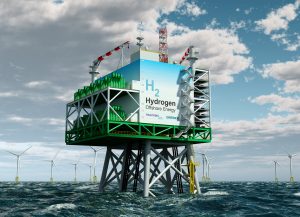400MW Offshore Hydrogen Production Takes System to New Levels
 Putting the brakes on climate change and meeting the challenges of the energy transition is now more urgent than ever. Tractebel offers a solution. An experienced team of energy experts from Tractebel Engineering and offshore engineers from Tractebel Overdick have developed a unique concept for an offshore platform.
Putting the brakes on climate change and meeting the challenges of the energy transition is now more urgent than ever. Tractebel offers a solution. An experienced team of energy experts from Tractebel Engineering and offshore engineers from Tractebel Overdick have developed a unique concept for an offshore platform.
This makes it possible to produce environmentally friendly ‘green’ hydrogen from offshore wind energy at an industrial scale using electrolysis. Delivering up to 400MW, this kind of plant exceeds the output of previous technologies many times over. This future-oriented concept is already at the stage where it could be put into practice today, for example in the North Sea. Using an innovative offshore platform as the basis, it enables a number of tasks to be solved simultaneously. First, it enables the proportion of green hydrogen (H2) in the energy mix to be effectively increased on a CO2-neutral basis. Second, the wide range of options for transporting H2 provides relief for the electricity transmission grid, the capacities of which are limited. And third, H2 as an efficient energy storage medium can balance out seasonal fluctuations in renewable energy sources.
Hydrogen can play an increasingly important role in the energy mix because it serves as an efficient form of storing energy and is easily transportable. Existing infrastructure consisting of gas pipelines and storage facilities such as underground caverns can be used for this purpose. H2 can also be stored on ships and transported anywhere in the world. As a source of energy, H2 is used to power gas engines, gas turbines and fuel cells, but can also be used as a supplement to natural gas in private households, for example. In addition, hydrogen is a key industrial raw material and source material for the production of ammonia, for example. It can also be used as a CO2-neutral reducing agent to substitute coke in steel production. “In large-scale offshore wind farms in the German North Sea and other locations there is enormous potential for CO2-neutral production of green hydrogen”, says Klaas Oltmann, Director of Business Development at Tractebel Overdick. Based on the new type of platform model, he and his Tractebel colleagues are currently working on a detailed solution for the use of the platform on an industrial scale (up to 400MW). It accommodates all the technical components required to produce green hydrogen. This includes the electrolysis units and transformers for the transformation of the electricity supplied by the offshore wind turbines, along with desalination plants for producing high-purity water required for electrolysis. The means of transport for the generated energy are diverse and flexible. High-voltage cables on the seabed are currently used to transfer the wind-generated electricity to the mainland. Capacities are limited – which is one of the reasons why the expansion of offshore windfarms has stalled in Germany. Offshore-generated hydrogen as a source of energy opens additional options, as it can be transported in both pipelines and ships. In this way, offshore H2 production could make further expansion of wind turbines possible without straining current limited electrical grid capacity. Moreover, hydrogen can also make an important contribution on the mainland too, by providing relief for the situation with regards to the distribution of electricity from north to south.
Compared to the costs of production of grey hydrogen from fossil sources, the costs for green hydrogen are currently higher. “On the basis of the economies of scale that we are currently observing in large-scale electrolysis plants and a higher tax on CO2 emissions, that will change,” says Tractebel Project Engineer Felix Knicker, “which will put the different technologies on a level footing with each other in terms of opportunities.” The critical cost factor is the design of the system and the efficiency of the plants for the production of green hydrogen. “Our concept includes the appropriate solutions for cost-optimised designs and efficient operation,” observes Mr Knicker. Future demand will also increase the competitiveness of the new technologies as well: “Offshore wind power is the only source for renewable energy in Germany which provides sufficient potential for expansion. Wind farms at sea will be installed at ever greater distances from the coast and in much deeper water in the future. That leads to higher costs for the construction of the plants and transport via high-voltage cables. We can offer an alternative which is attractive in economic terms”, emphasises Dr Hubert Schillings, Business Development Manager at Tractebel. The German federal government is currently preparing invitations to tender for test fields for the conversion of electricity into hydrogen (Power-to-X) in the regional development plan for the North Sea and Baltic Sea area. This provides the opportunity for the development of offshore hydrogen production platforms on a scale of several hundred megawatts. Investments such as these could be attractive for wind farm operators and energy suppliers or industrial companies which use hydrogen in their production processes.
Tractebel already has the suitable concept today – from feasibility study through detailed design. As part of the ENGIE Group the company is in a perfect position to deliver and operate offshore H2 platforms as an EPC supplier and to offer solutions for large-scale storage. “We anticipate that it could be possible for offshore H2 platforms to be constructed and put into operation starting in 2025. Individual demonstration plants could even be built before then,” add Mr Schillings.






